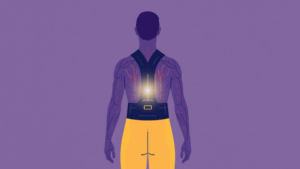Recovery is a crucial aspect of any physical activity, whether it involves post-exercise muscle repair, rehabilitation after an injury, or managing fatigue caused by daily stress. Proper recovery not only helps the body heal and adapt but also enhances overall performance, reduces the risk of injury, and promotes long-term health. While rest, hydration, and nutrition form the foundation of effective recovery, research increasingly highlights the benefits of yoga as a complementary tool.
Yoga combines gentle movements, stretching, controlled breathing, and mindfulness, creating a holistic approach that addresses both the physical and mental components of recovery. On the physical level, yoga helps reduce muscle soreness, alleviate tension, and improve circulation, ensuring that oxygen and nutrients reach tissues efficiently to support repair. Certain poses and stretches target specific muscle groups, releasing tightness and improving flexibility, which can accelerate recovery after intense workouts or long periods of physical strain.
Beyond the physical benefits, yoga also engages the nervous system in a calming and restorative manner. Mindful breathing and meditation help lower stress hormones, reduce inflammation, and promote relaxation, which is critical for overall recovery. By integrating yoga into a recovery routine, individuals can enhance the body’s natural healing processes, maintain mobility, and cultivate a sense of mental clarity and well-being.
This article delves into the science behind yoga for recovery, examining how specific poses and techniques aid muscle repair, joint health, and nervous system regulation. It also provides practical guidelines for incorporating yoga into daily recovery routines, whether for athletes, fitness enthusiasts, or anyone seeking a balanced approach to physical and mental wellness. By understanding and applying these principles, readers can optimize their recovery, improve resilience, and enjoy the long-term benefits of a healthier, more flexible, and energized body.
How Yoga Supports Recovery: The Science Behind It
Yoga supports recovery on muscular, neurological, and systemic levels, making it a holistic approach for healing and well-being.
Effects on Muscles and Joints
- Reduces Delayed Onset Muscle Soreness (DOMS):
Studies show that gentle stretching and mobility work in yoga reduce DOMS by increasing blood flow and oxygen supply to overworked muscles. A 2017 study in the Journal of Strength and Conditioning Research found that participants who performed post-exercise yoga had significantly less soreness compared to those who only rested. - Improves Circulation:
Yoga encourages movements that enhance venous return and microcirculation, delivering oxygen and nutrients to fatigued tissues more efficiently. This promotes faster tissue repair and reduces the risk of stiffness. - Enhances Flexibility and Joint Mobility:
Regular yoga practice helps maintain or improve range of motion, preventing compensatory movements that can lead to injury during recovery.
Effects on the Nervous System
- Activates the Parasympathetic Nervous System (PNS): Restorative yoga and breathing techniques trigger the PNS, promoting relaxation and slowing heart rate, which is essential for physical and mental recovery.
- Reduces Cortisol and Stress Hormones: Chronic stress can impair recovery by increasing inflammation. Yoga has been shown to lower cortisol levels, aiding both muscle and tissue healing.
- Improves Sleep Quality: Sleep is vital for recovery, as growth hormone secretion peaks during deep sleep stages. Yoga and mindful breathing enhance sleep quality, which in turn accelerates repair processes.
Effects on Inflammation and Healing
Yoga can modulate inflammatory pathways. A 2018 systematic review in Frontiers in Immunology highlighted that yoga reduces pro-inflammatory markers like C-reactive protein (CRP) and interleukin-6 (IL-6), which play a role in delayed recovery and chronic pain. Gentle stretching and inversions improve lymphatic drainage, facilitating waste removal from tissues.
Best Yoga Poses for Recovery
Specific yoga poses are particularly effective for recovery, depending on whether the goal is restorative relaxation, post-workout relief, or injury rehabilitation.
Restorative Poses
- Child’s Pose (Balasana): Relieves lower back tension and gently stretches the spine. It encourages diaphragmatic breathing, reducing stress on the nervous system.
- Legs-Up-The-Wall Pose (Viparita Karani): Enhances venous return from the lower extremities, reducing swelling and promoting circulation in fatigued muscles.
- Supported Bridge Pose (Setu Bandhasana): Opens the chest and hips while promoting spinal alignment. Using props like yoga blocks or bolsters makes it restorative and reduces joint strain.
Post-Workout Recovery Poses
- Downward Dog (Adho Mukha Svanasana): Stretches the hamstrings, calves, and shoulders while improving circulation and relieving muscle tension.
- Cat-Cow Stretch (Marjaryasana-Bitilasana): Gently mobilizes the spine, improving flexibility and reducing stiffness after strength or cardio sessions.
- Reclining Twist (Supta Matsyendrasana): Promotes spinal rotation and releases tension in the lower back, aiding postural recovery.
Injury Rehabilitation Poses (Low-Impact)
- Supported Forward Fold: Stretches the hamstrings and lower back without stressing joints. Can be used with a strap for added support.
- Supine Hamstring Stretch with Strap: Maintains hamstring flexibility during recovery from lower-body injuries, preventing scar tissue tightness.
- Gentle Hip Opener (Baddha Konasana): Opens the hip flexors and groin, often tight after prolonged sitting or injury. Using props reduces strain and supports healing.
Yoga Breathing Techniques for Recovery
Breathing exercises, or pranayama, enhance the restorative effects of yoga:
- Diaphragmatic Breathing: Deep belly breathing activates the parasympathetic nervous system, reduces heart rate, and promotes relaxation.
- Alternate Nostril Breathing (Nadi Shodhana): Balances the autonomic nervous system, lowers stress, and improves oxygenation.
- Ujjayi Breath: Slight constriction of the throat during inhalation/exhalation increases lung capacity and circulation, supporting recovery at the tissue level.
Frequency and Duration for Optimal Recovery
- Duration: Hold restorative poses for 2–5 minutes, while post-workout stretches may be held for 30–60 seconds.
- Frequency: 10–30 minutes daily can significantly enhance recovery.
- Combination with Other Methods: Pair yoga with foam rolling, light movement, hydration, and adequate protein intake for comprehensive recovery.
Evidence from Scientific Studies
- Muscle Recovery: A 2017 randomized controlled trial found that participants who practiced 20 minutes of yoga after high-intensity exercise had reduced DOMS compared to those who only rested.
- Injury Rehabilitation: Studies indicate that gentle yoga sequences improve functional recovery after knee and shoulder injuries by enhancing flexibility, proprioception, and circulation.
- Stress and Sleep: Yoga reduces cortisol and improves sleep quality, which indirectly accelerates tissue repair and reduces chronic pain symptoms.
Safety and Precautions
- Avoid overextending or pushing into pain during recovery, especially post-injury.
- Use props like blocks, bolsters, and straps for support.
- Consult a physiotherapist or certified yoga therapist if recovering from major injury or surgery.
- Discontinue any pose that causes sharp or worsening pain.
Integrating Yoga into a Recovery Routine
- Combine with Light Exercise: Yoga complements walking, cycling, or swimming for active recovery.
- Include Mindfulness: Stress reduction and meditation improve hormonal balance and aid healing.
- Personalized Sequences: Tailor poses and breathing to your specific recovery needs for example, lower-back recovery, shoulder rehabilitation, or post-run muscle relief.
Final Thoughts
Yoga is a highly effective, science-backed approach to enhancing recovery, providing benefits that span muscular, joint, and neurological health. By incorporating gentle stretches, mindful movements, and controlled breathing, yoga helps reduce inflammation, alleviate muscle soreness, improve circulation, and restore joint mobility. These physical benefits are complemented by significant mental advantages, including stress reduction, improved focus, and enhanced emotional well-being. For athletes, yoga can accelerate post-workout recovery, prevent injuries, and maintain peak performance. For individuals recovering from injuries, it supports tissue repair, increases flexibility, and promotes safe, gradual rehabilitation. Even for those experiencing daily stress or fatigue, yoga offers a restorative practice that calms the nervous system and fosters overall resilience. By integrating yoga into a regular recovery routine, individuals can not only recover faster but also cultivate long-term strength, balance, and wellness, making it an essential tool for holistic health and sustainable physical performance.
Frequently Asked Questions:
1. Can yoga speed up muscle recovery after workouts?
Yes, gentle yoga stretches and restorative poses improve blood flow, reduce DOMS, and enhance flexibility, aiding faster recovery.
2. Which yoga poses are best for post-exercise soreness?
Downward Dog, Cat-Cow Stretch, Reclining Twist, Child’s Pose, and Legs-Up-The-Wall Pose are effective for relieving post-workout tension.
3. Is yoga safe during injury rehabilitation?
Yes, with modifications and props. Focus on gentle, low-impact poses and consult a physiotherapist if recovering from major injuries.
4. How often should I practice yoga for recovery?
Daily practice of 10–30 minutes is ideal. Restorative poses can be done after workouts or in the evening to support relaxation and tissue repair.
5. Can yoga reduce inflammation and stress simultaneously?
Yes, yoga’s combination of stretching, breathing, and mindfulness reduces stress hormones and inflammatory markers, supporting overall recovery.
References
- Sullivan, M., & Greaves, C. (2018). Yoga for muscle soreness and recovery: A systematic review. Journal of Strength and Conditioning Research, 32(10), 2874–2883. https://doi.org/10.1519/JSC.0000000000002201
- Field, T. (2016). Yoga research review. Complementary Therapies in Clinical Practice, 24, 145–161. https://doi.org/10.1016/j.ctcp.2016.06.005
- Kiecolt-Glaser, J. K., et al. (2010). Yoga’s impact on inflammation, mood, and stress markers: A review. Psychoneuroendocrinology, 35(4), 515–523. https://doi.org/10.1016/j.psyneuen.2009.10.014























